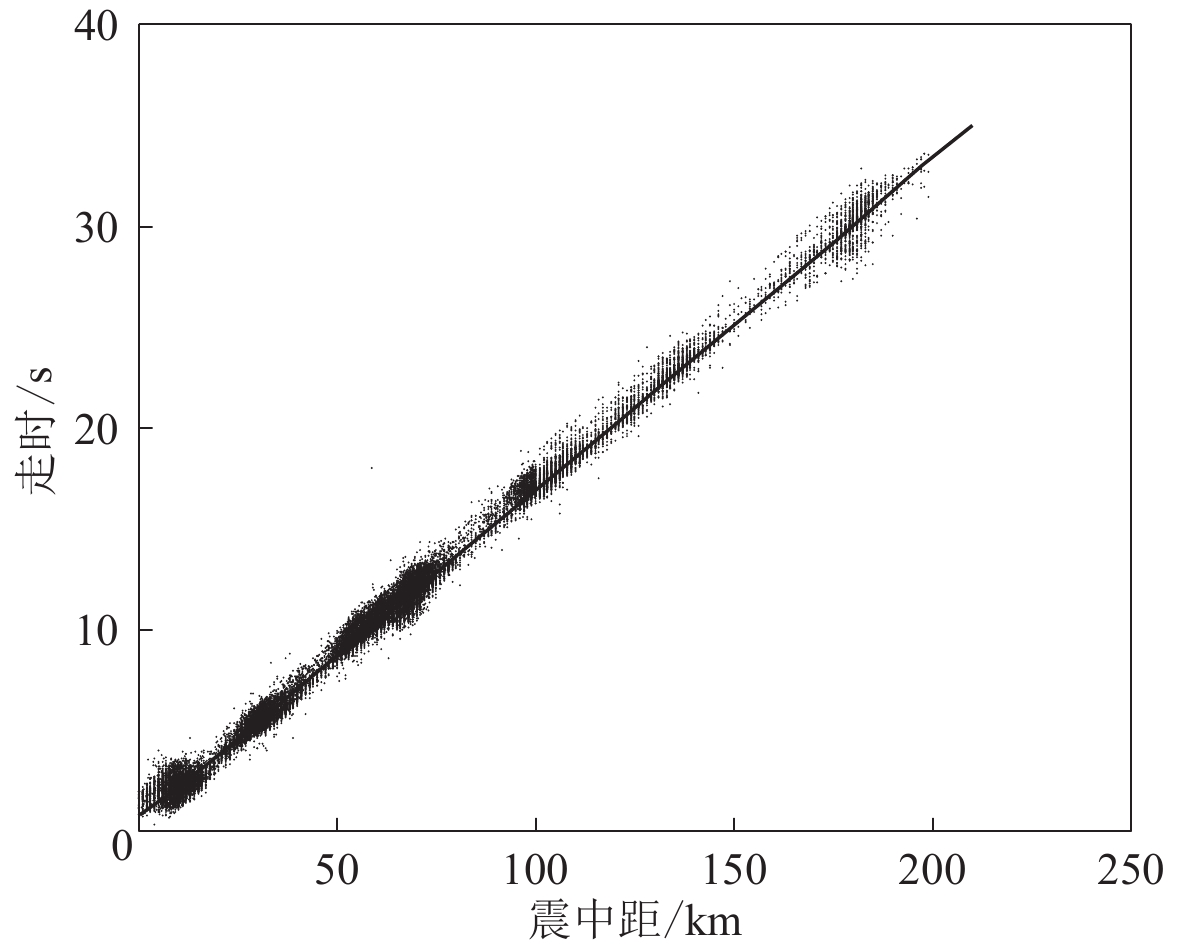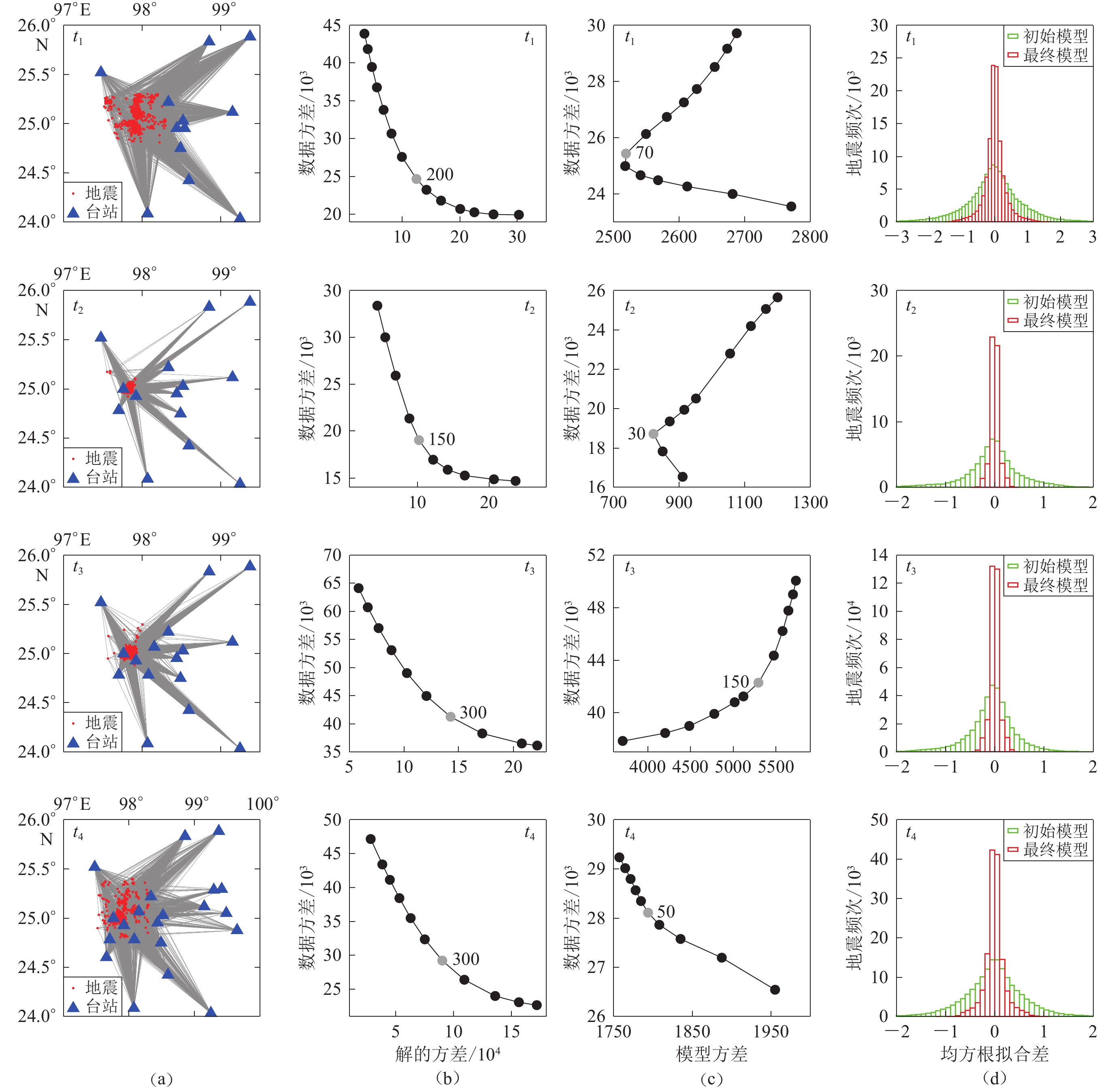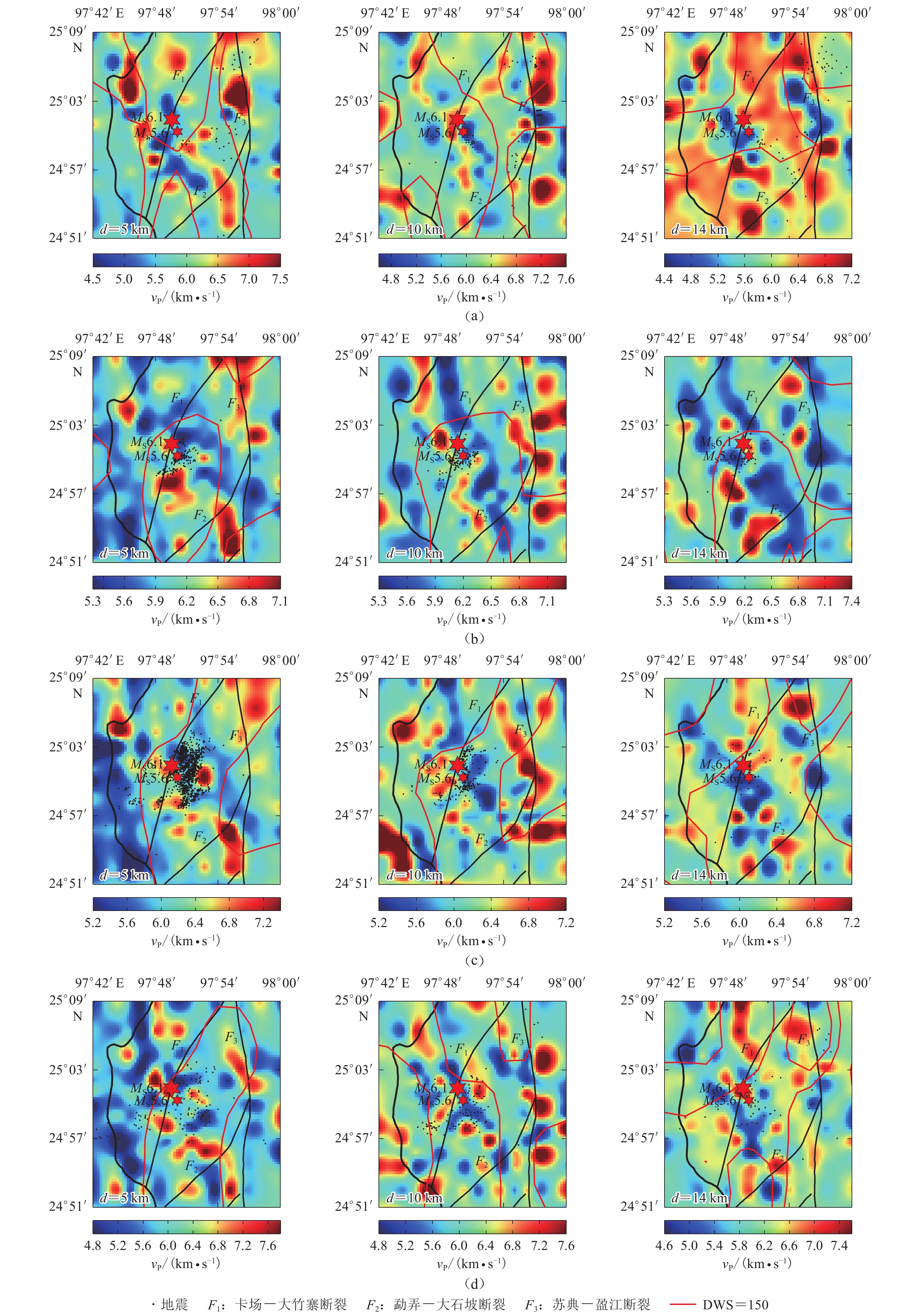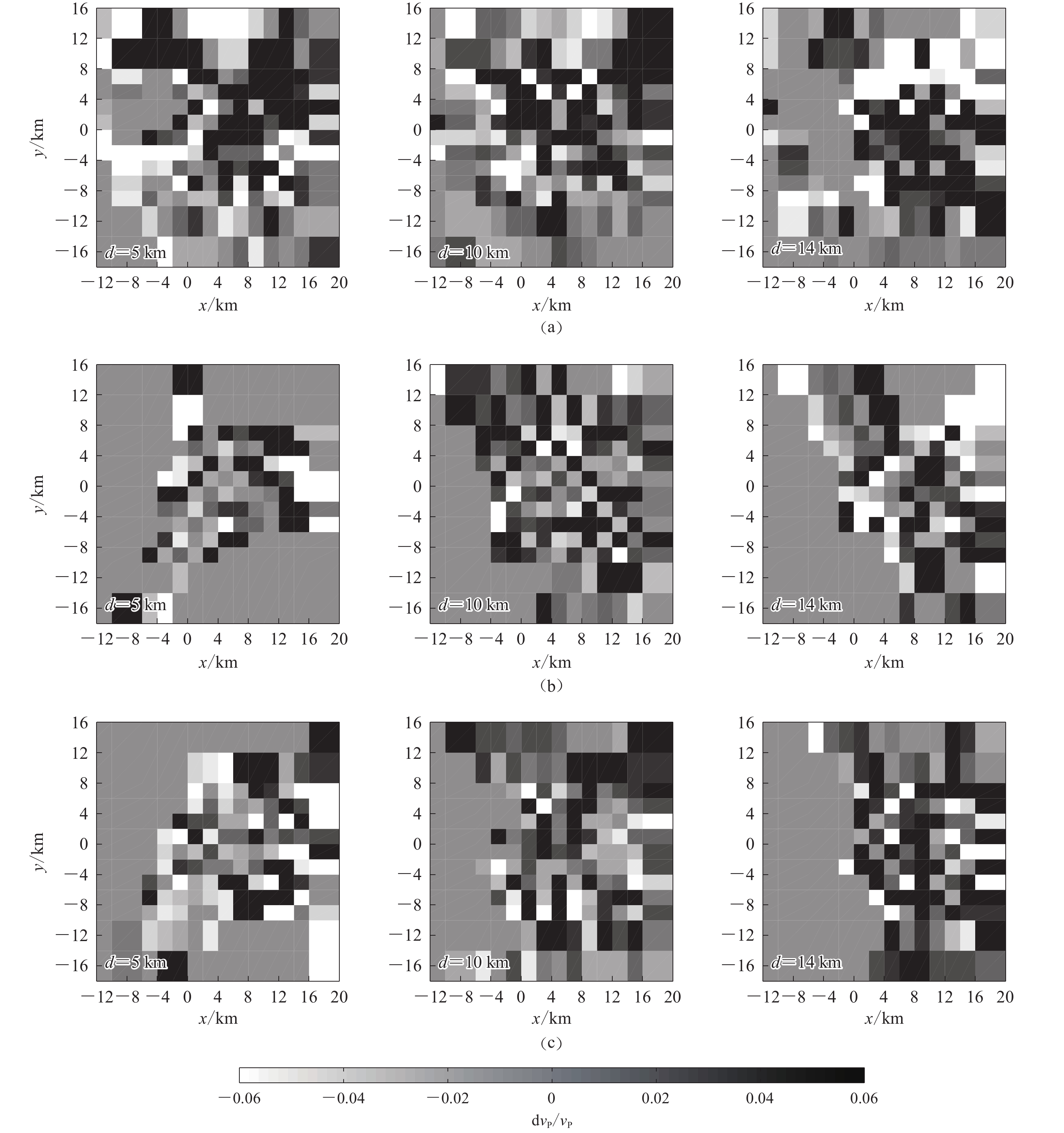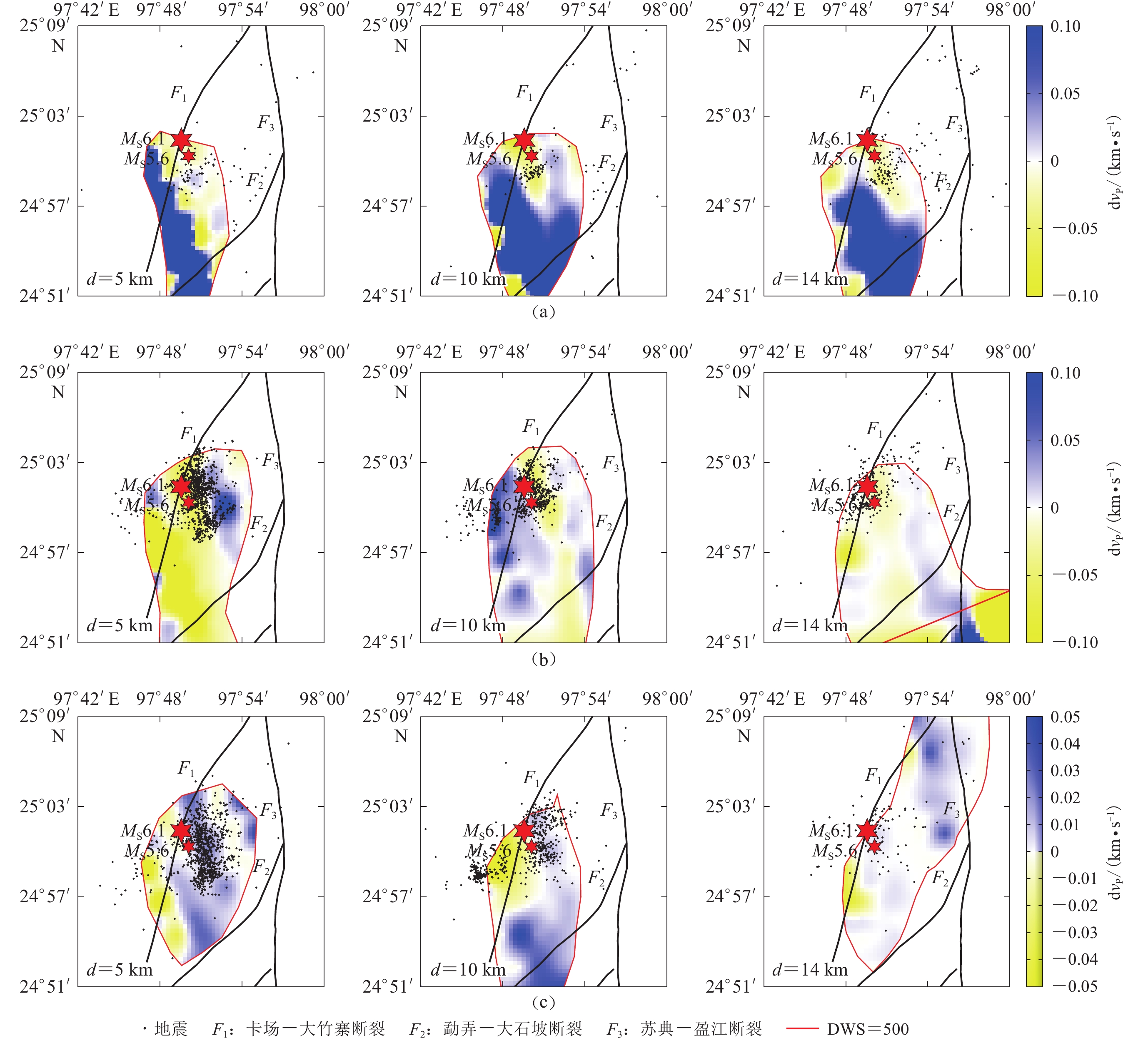P-wave velocity changes in the source area before and after two moderate strong earthquakes in Yingjiang, Yunnan in 2014
-
摘要: 基于云南地震台网的地震记录,利用基于双差层析成像的时移层析成像方法,开展了2014年5月24日盈江MS5.6和5月30日MS6.1地震前后震源区地下P波速度变化的时空特征研究。结果表明:在盈江MS5.6地震后,震源区的P波速度轻微下降,在MS6.1地震后,相对于MS5.6地震,P波速度继续下降,并下降至最低,下降幅度约为1%,说明P波速度下降的幅度可能与主震的震级大小相关。另外,本研究还观测到P波速度下降与余震分布的时空变化相关,可能是由于余震的动态和静态应力变化造成震源区介质物理性质发生改变,从而导致地震波速度的变化。在两次地震发生后约五年内,震源区P波速度值上升,上升幅度小于震后总下降幅度,但这并不能表明震源区还处于愈合过程中。Abstract: The time-lapse tomography method based on double-difference tomography can obtain high-precision seismic wave velocity changes. In this study, we applied this method to the seismic data set that recorded by the Yunnan seismic network to obtain the spatiotemporal changes of P-wave velocity in the source area during the MS5.6 and MS6.1 Yingjiang earthquakes in 2014. The results showed that the spatial and temporal characteristics of the P-wave velocity of the crust at depth around the source area suggest co-seismic velocity reductions. After the MS5.6 earthquake occurred on May 24, the P-wave velocity of the crust dropped slightly. After the MS6.1 earthquake occurred on May 30, the P-wave velocity dropped definitely with an amplitude of about 1%. It showed that the amplitude of the reduction is related to the magnitude of the mainshock. We also reported that P-wave velocity is also related to the the spatio-temporal changes of aftershocks distribution. It is possible that of dynamic and static stresses changes of the aftershocks caused changes of the physical properties in the source area which leads to the velocity change. Finally, about five years after the Yingjiang earthquakes, a healing process is observed. And the rising level did not reach the previous falling level. However, this does not mean that the source area is still in the healing process.
-
-
图 5 四时段的参数信息
(a) 二维射线分布;(b) 不同阻尼参数的解的方差和数据方差的均衡曲线;(c) 不同平滑权重参数的模型方差和数据方差的均衡曲线;(d) 不同模型下的观测走时与理论走时的均方根拟合差变化
Figure 5. The parameter information of four periods
(a) Distribution of 2-D P wave ray paths;(b) The trade-off curves of solution variance and data variance for different damping parameters;(c) The trade-off curve of slowness model variance and data variance for a set of smoothing weight parameters;(d) The root-mean-square misfit improvement between observation travel times and theoretical ones based on 3D models
表 1 初始一维速度模型
Table 1 The initial 1D velocity model
深度/km 速度/(km·s−1) 0 5.000 2 5.367 5 5.803 7 6.033 10 6.126 14 6.400 18 6.600 25 6.800 30 7.200 38 8.000 表 2 盈江两次中强震四个时段的数据分布
Table 2 Data of the four periods for two moderate strong earthquakes in Yingjiang
时间段 时间窗 台站个数 地震次数 绝对到时/条 相对到时/条 t1 2009−01−01—2014−05−23 12 679 4310 64208 t2 2014−05−24—2014−05−29 14 947 6054 67628 t3 2014−05−30—2014−07−31 16 3982 35139 160560 t4 2014−08−01—2019−12−31 21 1007 8517 78155 表 3 4个时段反演前后到时差的均方根残差变化
Table 3 The RMS residuals between observed and predicted differential travel times after and before tomography for the four periods
时段 到时差的均方根残差/s 下降百分比 时段 到时差的均方根残差/s 下降百分比 初始三维速度模型 最终三维速度模型 初始三维速度模型 最终三维速度模型 t1 0.519 0.203 60.9% t3 0.318 0.052 83.6% t2 0.317 0.048 85.8% t4 0.404 0.117 71% 表 4 时移层析成像所用到的数据
Table 4 The data of time-lapse tomography
时间段 地震次数 台站/个 P波到时差/个 t2-t1 1626 14 10364 t3-t2 4929 16 41193 t4-t3 4989 21 43656 表 5 相邻两个时间段反演前后到时差的均方根残差变化
Table 5 The RMS residuals between observed and predicted differential travel times after and before tomography varies for two adjacent time periods
时间段 到时差的均方根残差/s 下降百分比 初始三维模型 三维速度变化 t2-t1 0.279 0.097 65.2% t3-t2 0.140 0.016 88.6% t4-t3 0.180 0.015 91.7% -
陈飞. 2017. 利用面波与重力的联合反演确定中国大陆三维岩石圈速度结构[D]. 合肥: 中国科学技术大学: 30–38. Chen F. 2017. Lithospheric Shear Wave Tomography of Continental China by Joint Inversion of Surface-Wave and Satellite Gravity Data[D]. Hefei: University of Science and Technology of China: 30–38 (in Chinese).
房立华,吴建平,张天中,黄静,王长在,杨婷. 2011. 2011年云南盈江MS5.8地震及其余震序列重定位[J]. 地震学报,33(2):262–267. doi: 10.3969/j.issn.0253-3782.2011.02.013 Fang L H,Wu J P,Zhang T Z,Huang J,Wang C Z,Yang T. 2011. Relocation of mainshock and aftershocks of the 2011 Yingjiang MS5.8 earthquake in Yunnan[J]. Acta Seismologica Sinica,33(2):262–267 (in Chinese).
黄璟. 2012. 滇西地区三维速度结构研究[D]. 北京: 中国地震局地球物理研究所: 23–25. Huang J. 2012. 3D Velocity Structure Study in Western Yunnan[D]. Beijing: Institute of Geophysics, China Earthquake Administration: 23–25 (in Chinese).
李飞,周仕勇,苏有锦,李鹏,邓存华,李雷,王兰兰. 2011. 川滇及邻区Pn波速度结构和各向异性研究[J]. 地球物理学报,54(1):44–54. doi: 10.3969/j.issn.0001-5733.2011.01.006 Li F,Zhou S Y,Su Y J,Li P,Deng C H,Li L,Wang L L. 2011. Study on Pn-wave velocity structure and anisotropy in the Sichuan-Yunnan and its adjacent areas[J]. Chinese Journal of Geophysics,54(1):44–54 (in Chinese).
刘志坤,黄金莉. 2010. 利用背景噪声互相关研究汶川地震震源区地震波速度变化[J]. 地球物理学报,53(4):853–863. doi: 10.3969/j.issn.0001-5733.2010.04.010 Liu Z K,Huang J L. 2010. Temporal changes of seismic velocity around the Wenchuan earthquake fault zone from ambient seismic noise correlation[J]. Chinese Journal of Geophysics,53(4):853–863 (in Chinese).
秦敏,李丹宁,张会苑,高洋,姜金钟. 2018. 云南盈江地区地震波非弹性衰减Q值、场地响应及震源参数研究[J]. 地震研究,41(4):583–593. doi: 10.3969/j.issn.1000-0666.2018.04.013 Qin M,Li D N,Zhang H Y,Gao Y,Jiang J Z. 2018. Research on inelastic attenuation Q-value,site response and source parameters in Yunnan Yingjiang region[J]. Journal of Seismological Research,41(4):583–593 (in Chinese).
孙洁,徐常芳,江钊,史书林,王继军,何明. 1989. 滇西地区地壳上地幔电性结构与地壳构造活动的关系[J]. 地震地质,11(1):35–45. Sun J,Xu C F,Jiang Z,Shi S L,Wang J J,He M. 1989. The electrical structure of the crust and upper mantle in the west part of Yunnan Province and its relation to crustal tectonics[J]. Seismology and Geology,11(1):35–45 (in Chinese).
孙楠,高原,赵小艳,苏有锦,刘庚,邬成栋. 2017. 盈江MS6.1地震序列近场横波分裂研究[J]. 地震学报,39(1):34–46. doi: 10.11939/jass.2017.01.004 Sun N,Gao Y,Zhao X Y,Su Y J,Liu G,Wu C D. 2017. Near-field shear-wave splitting of 2014 Yingjiang MS6.1 earthquake sequence[J]. Acta Seismologica Sinica,39(1):34–46 (in Chinese).
肖卓,高原. 2016. 运用尾波干涉技术监测2014年盈江双震期间地壳介质状态的变化[J]. 地球物理学进展,31(6):2421–2428. doi: 10.6038/pg20160609 Xiao Z,Gao Y. 2016. Monitoring dynamic variations of crustal media during 2014 Yingjiang double earthquakes by coda wave interferometry[J]. Progress in Geophysics,31(6):2421–2428 (in Chinese).
徐甫坤,张彦琪,苏有锦. 2015. 2014年云南盈江MS6.1地震前后序列分布差异研究[J]. 地震研究,38(4):525–534. Xu F K,Zhang Y Q,Su Y J. 2015. Research on difference of sequence distribution before and after Yingjiang MS6.1 earthquake in Yunnan Province in 2014[J]. Journal of Seismological Research,38(4):525–534 (in Chinese).
许力生,严川,张旭,付虹,李春来,郭祥云. 2014. 2014年盈江双震的破裂历史[J]. 地球物理学报,57(10):3270–3284. doi: 10.6038/cjg20141015 Xu L S,Yan C,Zhang X,Fu H,Li C L,Guo X Y. 2014. Rupture histories of the 2014 Yingjiang double earthquakes[J]. Chinese Journal of Geophysics,57(10):3270–3284 (in Chinese).
杨婷,吴建平,房立华,王长在. 2014. 滇西地区地壳速度结构及其构造意义[J]. 地震地质,36(2):392–404. doi: 10.3969/j.issn.0253-4967.2014.02.010 Yang T,Wu J P,Fang L H,Wang C Z. 2014. 3-D crustal P-wave velocity structure in western Yunnan area and its tectonic implications[J]. Seismology and Geology,36(2):392–404 (in Chinese).
杨婷,吴建平,房立华,王未来. 2016. 2014年云南盈江MS5.6和MS6.1地震余震序列重定位[J]. 地震地质,38(4):1047–1057. Yang T,Wu J P,Fang L H,Wang W L. 2016. Relocation of main shock and aftershocks of the 2014 Yingjiang MS5.6 and MS6.1 earthquakes in Yunnan[J]. Seismology and Geology,38(4):1047–1057 (in Chinese).
张彦琪,陈维锋,卢永坤,陈坤华,林国良,李世成. 2017. 2014年云南3次MS>6地震灾害特征对比分析[J]. 地震研究,40(1):144–152. Zhang Y Q,Chen W F,Lu Y K,Chen K H,Lin G L,Li S C. 2017. Research on the disaster characteristics of three MS>6 earthquakes in Yunnan in 2014[J]. Journal of Seismological Research,40(1):144–152 (in Chinese).
Julian B R, Foulger G R, Monastero F C. 2008. Time-dependent seismic tomography and its application to the Coso geothermal area, 1996-2006[C]//Proceedings of the Thirty-Third Workshop on Geothermal Reservoir Engineering. Stanford, California: Stanford University: 387–390.
Julian B R,Foulger G R. 2010. Time-dependent seismic tomography[J]. Geophys J Int,182(3):1327–1338. doi: 10.1111/j.1365-246X.2010.04668.x
Koulakov I,Gladkov V,El Khrepy S,Al-Arifi N,Fathi I H. 2016. Application of repeated passive source travel time tomography to reveal weak velocity changes related to the 2011 Tohoku-Oki MW9.0 earthquake[J]. J Geophys Res:Solid Earth,121(6):4408–4426. doi: 10.1002/2016JB013002
Lei J S,Zhao D P,Su Y J. 2009. Insight into the origin of the Tengchong intraplate volcano and seismotectonics in southwest China from local and teleseismic data[J]. J Geophys Res:Solid Earth,114(B5):B05302. doi: 10.1029/2008JB005881
Lei J S,Zhao D P,Xie F R,Liu J. 2011. An attempt to detect temporal variations of crustal structure in the source area of the 2006 Wen-An earthquake in North China[J]. J Asian Earth Sci,40(4):958–976. doi: 10.1016/j.jseaes.2010.07.003
Lei J S,Zhao D P. 2016. Teleseismic P-wave tomography and mantle dynamics beneath eastern Tibet[J]. Geochem Geophys Geosys,17(5):1861–1884. doi: 10.1002/2016GC006262
Lei J S,Zhao D P,Xu X W,Xu Y G,Du M F. 2019. Is there a big mantle wedge under eastern Tibet?[J]. Phys Earth Planet Inter,292:100–113. doi: 10.1016/j.pepi.2019.04.005
Obermann A,Froment B,Campillo M,Larose E,Planès T,Valette B,Chen J H,Liu Q Y. 2014. Seismic noise correlations to image structural and mechanical changes associated with the MW7.9 2008 Wenchuan earthquake[J]. J Geophys Res:Solid Earth,119(4):3155–3168. doi: 10.1002/2013JB010932
Patanè D,Barberi G,Cocina O,De Gori P,Chiarabba C. 2006. Time-resolved seismic tomography detects magma intrusions at Mount Etna[J]. Science,313(5788):821–823. doi: 10.1126/science.1127724
Qian J W,Zhang H J,Westman E. 2018. New time-lapse seismic tomographic scheme based on double-difference tomography and its application in monitoring temporal velocity variations caused by underground coal mining[J]. Geophys J Int,215(3):2093–2104. doi: 10.1093/gji/ggy404
Wang C Y,Chan W W,Mooney W D. 2003. Three-dimensional velocity structure of crust and upper mantle in southwestern China and its tectonic implications[J]. J Geophys Res:Solid Earth,108(B9):2442.
Zhang H J,Thurber C H. 2003. Double-difference tomography:The method and its application to the Hayward fault,California[J]. Bull Seismol Soc Am,93(5):1875–1889. doi: 10.1785/0120020190
Zhang H J,Thurber C. 2006. Development and applications of double-difference seismic tomography[J]. Pure Appl Geophys,163(2):373–403.
-
期刊类型引用(9)
1. 王玮铭,冯志生,朱培育,廖晓峰,何畅,张致伟. 2021年9月16日四川泸县M_S6.0地震前地磁扰动异常特征分析. 地震工程学报. 2025(01): 229-239 .  百度学术
百度学术
2. 宗昕冉,陈海军. 原子磁力仪的研究进展与发展趋势. 激光与光电子学进展. 2025(07): 78-95 .  百度学术
百度学术
3. 艾萨·伊斯马伊力,张桉赫,宋春燕,刘海洋,翟世龙,冯丽丽,牛中华,熊攀,焦立果,贺曼秋. 2024年1月23日新疆乌什M_S7.1地震前电磁多参量异常. 地震. 2025(01): 63-80 .  百度学术
百度学术
4. 艾萨·伊斯马伊力,翟世龙,张桉赫,冯丽丽,贺曼秋,冯志生. 新疆地区电磁预测指标体系在2023年1月30日沙雅M_S6.1地震中的应用. 内陆地震. 2023(03): 272-280 .  百度学术
百度学术
5. 王玮铭,廖晓峰,任越霞,何畅,王迪. 2021年9月16日四川泸县M_S6.0地震前地磁垂直强度极化异常分析. 地震地磁观测与研究. 2023(S1): 93-96 .  百度学术
百度学术
6. 樊文杰,冯丽丽,李霞,何畅,廖晓峰,姚休义. 2022年1月8日青海门源M_S6.9地震前地磁垂直强度极化异常变化特征. 地震工程学报. 2022(03): 744-750 .  百度学术
百度学术
7. 冯丽丽,李霞,赵玉红,张朋涛. 2022年1月8日青海门源6.9级地震短临异常跟踪分析. 中国地震. 2022(01): 12-20 .  百度学术
百度学术
8. 李霞,冯丽丽,赵玉红,刘磊,苟智栋,樊文杰,贺曼秋,廖晓峰,艾萨·伊斯马伊力. 2017年西藏米林M_S6.9地震前地磁垂直强度极化异常特征. 地震学报. 2021(05): 584-594+678 .  本站查看
本站查看
9. 冯丽丽,管贻亮,樊文杰,贺曼秋,李霞,何畅,廖晓峰,艾萨·伊斯马伊力,袁文秀,刘素珍,冯志生. 2020年10月15日地磁垂直强度极化异常与玛多M7.4地震. 高原地震. 2021(04): 1-6 .  百度学术
百度学术
其他类型引用(1)





 下载:
下载:

